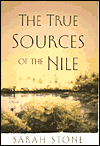The True Sources of the Nile
by Sarah Stone. Doubleday, 2002. 289 pages.

Anne Copeland, the heroine of this skillfully written first novel, is a Californian in her thirties who lives and works in Bujumbura, the capital of Burundi. After a stint at a health clinic, she has gone to work for a tiny human rights organization, one of whose aims is to gain the release of political prisoners. At an official reception she meets Jean-Pierre Bukimana, a cultured and elegant government minister allied with the Tutsi elite. Their affair is not only sexually intense but intellectually and emotionally intimate. "I had the sense," she thinks, "of seeing in tandem, of being half of a two-part unit of perception and analysis." Being with Jean-Pierre makes her think about the world in a way she is amazed to realize she never has before.
One of the novel's strengths is its presentation of the heroine's conflicted motivations, and her awareness of them. Is her work in Burundi noble and courageous, or is she in fact "self-righteous and self-absorbed"? Is her place in her adopted country or at home in San Francisco with her ailing mother? And how much does her infatuation with Jean-Pierre cloud her political understanding? The reader's sense that there might be a something a little trashy about the well-brought-up young woman's exotic affair is anticipated by Anne herself, who wonders whether she has managed to find a love who resembles the bold, unscrupulous military officers in the cheap romances that her mother devours. But if this is in some sense a trashy novel, its self-awareness makes it a thinking person's trashy novel.
Burundi has long been bracketed with its neighbor Rwanda in the minds of outsiders, and frequently overshadowed. Both of these small, hilly, densely populated countries share a complicated history of struggle between a Hutu majority and a Tutsi minority. The Belgian colonists of both countries took a social system in which the categories of "Hutu" and "Tutsi" were relatively fluid and informal and formalized it into a rigid structure in which every African had a permanent identity, and political power and educational opportunities were apportioned to the Tutsi ruling elite. In Burundi as in Rwanda, the result has been a series of violent outbreaks.
This novel takes place in Burundi in 1993. A new Hutu president has been elected, promising a government of reconciliation, but within months he is assassinated by elements of the Tutsi-led army, triggering reprisals and counterattacks. Anne witnesses a shocking episode from the bloodbath that eventually kills 50,000 Hutu and Tutsi, and before long she hears troubling rumors of Jean-Pierre's involvement in a previous violent outbreak, in 1972. She is startled to realize that for all of her time with him she had implicitly assumed that the Hutus were in the right simply because the Tutsis were the ones in power. She even finds that she gets a perverse sexual charge from making love with Jean-Pierre while interrogating him about his past, as if the do-good human rights worker can only find release with someone "bad."
The True Sources of the Nile brings Burundi out of the shadows. It includes a wealth of local color -- food, weather, folktales -- that together convey a distinctive picture of the country. Pizzas in Burundi, it seems, are flavored with cumin. Infants are given temporary names like Mouse Dung or Little Whore to make them undesirable to evil spirits. The domes of the national airport resemble a row of duck eggs.
More than that, however, this is a book about the scale of things: about the enormous impact that a small, out-of-the-way country can have on a person's life, and about how a major national tragedy can express itself in small ways: the loss of a friend, the planting of doubt in a love affair, the failure to save a single particular human being.
From The True Sources of the Nile:
Jean-Pierre arranged for the two of us to travel into the interior, the trip he'd once planned as a surprise, but now I knew about it ahead of time. We stayed in the hills above Muramvya, a long, steep, winding drive, up and up, as if we were driving into the sky. A Greek family had a series of bungalows and gardens on a hilltop, with a central restaurant, flower beds, a swing for the family's children, and lawns in the middle of the cultivated fields, which spread down the hills in all directions. We could stand at the edge of the gardens and look down over what seemed to be most of Burundi.
Dotted everywhere on the hills below were the round shapes of the rugos, clusters of round, thatched buildings that make up a homestead. The parents sleep in a central building where the family gathers for meals. The grandmother and the girls sleep in one hut (where the banana beer is kept), the grandfather, boys, and goats in another, and the cows in their own. Rippling banana trees and oil nut palms divided the green fields around the rugos into sections. The hills so green, so red, the sky so intensely gray. Glory.
Published in The African, January/February 2003.


